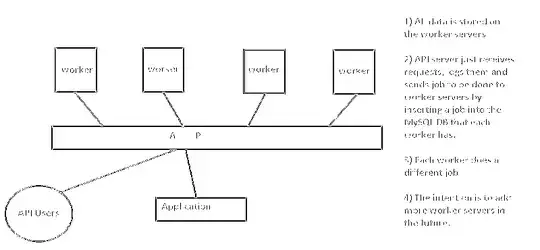Higher Availability
As Chris mentions, your API server is the single point of failure in your layout. What you're setting up is a message queuing infrastructure, something many people have implemented before.
Continue down the same path
You mention receiving requests on the API server and insert the job into a MySQL DB running on each server. If you want to continue on this path, I suggest removing the API server layer, and design the Workers to each accept commands directly from your API Users. You could use something as simple as round-robin DNS to distribute each API User connection directly to one of the available worker nodes (and retry if a connection isn't successful).
Use a Message Queue Server
More robust message queuing infrastructures use software designed for this purpose like ActiveMQ. You could use ActiveMQ's RESTful API to accept POST requests from API Users, and idle workers can GET the next message on the queue. However, this is probably overkill for your needs - it is designed for latency, speed, and millions of messages a second.
Use Zookeeper
As a middle ground, you may want to look at Zookeeper, even though it isn't specifically a message queue server. We use at $work for this exact purpose. We have a set of three servers (analogous to your API server) that run the Zookeeper server software, and have a web frontend for handling requests from users and applications. The web frontend, as well as the Zookeeper backend connection to the workers, have a load balancer to make sure we continue processing the queue, even if a server is down for maintenance. When the work is done, the worker tells the Zookeeper cluster that the job is complete. If a worker dies, that job will be sent to another work to complete.
Other concerns
- Make sure jobs complete in the event that a worker isn't responding
- How will the API know that a job is complete, and to retrieve it from the worker's database?
- Try to reduce the complexity. Do you need an independent MySQL server on each worker node, or could they talk to the MySQL server (or replicated MySQL Cluster) on the API server(s)?
- Security. Can anyone submit a job? Is there authentication?
- Which worker should get the next job? You don't mention whether the tasks are expected to take 10ms or 1 hour. If they are fast, you should remove layers to keep latency down. If they are slow, you should be very careful to make sure shorter requests don't get stuck behind a few long running ones.
